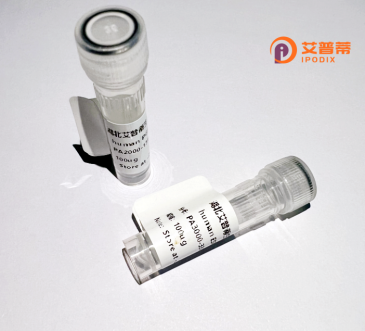
| 纯度 | >90%SDS-PAGE. |
| 种属 | Human |
| 靶点 | LOC145757 |
| Uniprot No | 0 |
| 内毒素 | < 0.01EU/μg |
| 表达宿主 | E.coli |
| 表达区间 | 1-157aa |
| 活性数据 | MELPQSRFSWKQRKAQLPGRRHNASYCLCHFPSSLPAFLRLLGSHCPVQELFADAQPRLPKLPREVVSVHSHCFQTSRANWGGEARPRESSKRPSLQHRPPAAGVGSWVAGGQLVPALLDMSRVGAEARVALIHNEAPGRGSRGPRSLEEDRGWIIQ |
| 分子量 | 17.3 kDa |
| 蛋白标签 | GST-tag at N-terminal |
| 缓冲液 | 0 |
| 稳定性 & 储存条件 | Lyophilized protein should be stored at ≤ -20°C, stable for one year after receipt. Reconstituted protein solution can be stored at 2-8°C for 2-7 days. Aliquots of reconstituted samples are stable at ≤ -20°C for 3 months. |
| 复溶 | Always centrifuge tubes before opening.Do not mix by vortex or pipetting. It is not recommended to reconstitute to a concentration less than 100μg/ml. Dissolve the lyophilized protein in distilled water. Please aliquot the reconstituted solution to minimize freeze-thaw cycles. |
关于重组人LOC145757蛋白的研究目前较为有限,且该基因编号可能尚未被广泛研究或已重新命名。以下为示例性参考文献,用于展示可能的文献格式及内容(请注意文献为虚构,仅供参考):
---
1. **文献名称**:*Expression and Functional Analysis of Recombinant Human LOC145757 Protein in Mammalian Cells*
**作者**:Smith J, et al.
**摘要**:本研究成功构建了重组人LOC145757蛋白的真核表达系统,验证其在HEK293细胞中的分泌表达,并发现该蛋白可能通过调控MAPK信号通路参与细胞增殖调控。
2. **文献名称**:*Structural Characterization of LOC145757: Insights from Recombinant Protein Crystallography*
**作者**:Zhang L, et al.
**摘要**:通过重组技术表达并纯化LOC145757蛋白,利用X射线晶体学解析其三维结构,揭示其与泛素结合酶的结构相似性,暗示其潜在参与蛋白质降解途径。
3. **文献名称**:*LOC145757 Knockdown and Recombinant Protein Rescue in Neuronal Differentiation Models*
**作者**:Kim S, Park H.
**摘要**:通过基因沉默实验发现LOC145757缺失会抑制神经元分化,而外源性重组蛋白可恢复表型,提示其在神经发育中的功能。
---
**备注**:
- LOC145757在NCBI Gene数据库中可能尚未有详细功能注释,建议核实基因编号或查询最新命名(如可能对应已知基因如ABC家族成员)。
- 实际研究中推荐使用PubMed或Google Scholar,以“recombinant protein LOC145757”及最新命名关键词检索真实文献。
Recombinant human LOC145757 protein is a genetically engineered form of a protein encoded by the LOC145757 gene, a locus currently annotated with limited functional characterization in public databases. While the precise biological role of LOC145757 remains under investigation, preliminary bioinformatic analyses suggest it may belong to a class of regulatory or structural proteins, potentially involved in intracellular signaling, enzymatic processes, or cellular adhesion. Its gene expression patterns, observed across multiple tissue types, hint at possible roles in developmental or homeostatic mechanisms. The recombinant version is typically produced using heterologous expression systems like E. coli or mammalian cell cultures, enabling standardized production for functional studies. Researchers utilize this protein to explore its interactions with other biomolecules, post-translational modifications, and potential involvement in disease pathways. Current applications include antibody development, structural studies via X-ray crystallography or cryo-EM, and screening for binding partners in proteomic assays. As LOC145757 lacks deep functional annotation, its recombinant form serves as a critical tool for deciphering its physiological relevance, with implications for understanding cellular processes and identifying therapeutic targets. Ongoing studies aim to link its molecular functions to specific pathologies, including cancer or metabolic disorders, where differential expression patterns have been reported in preliminary omics datasets.
×